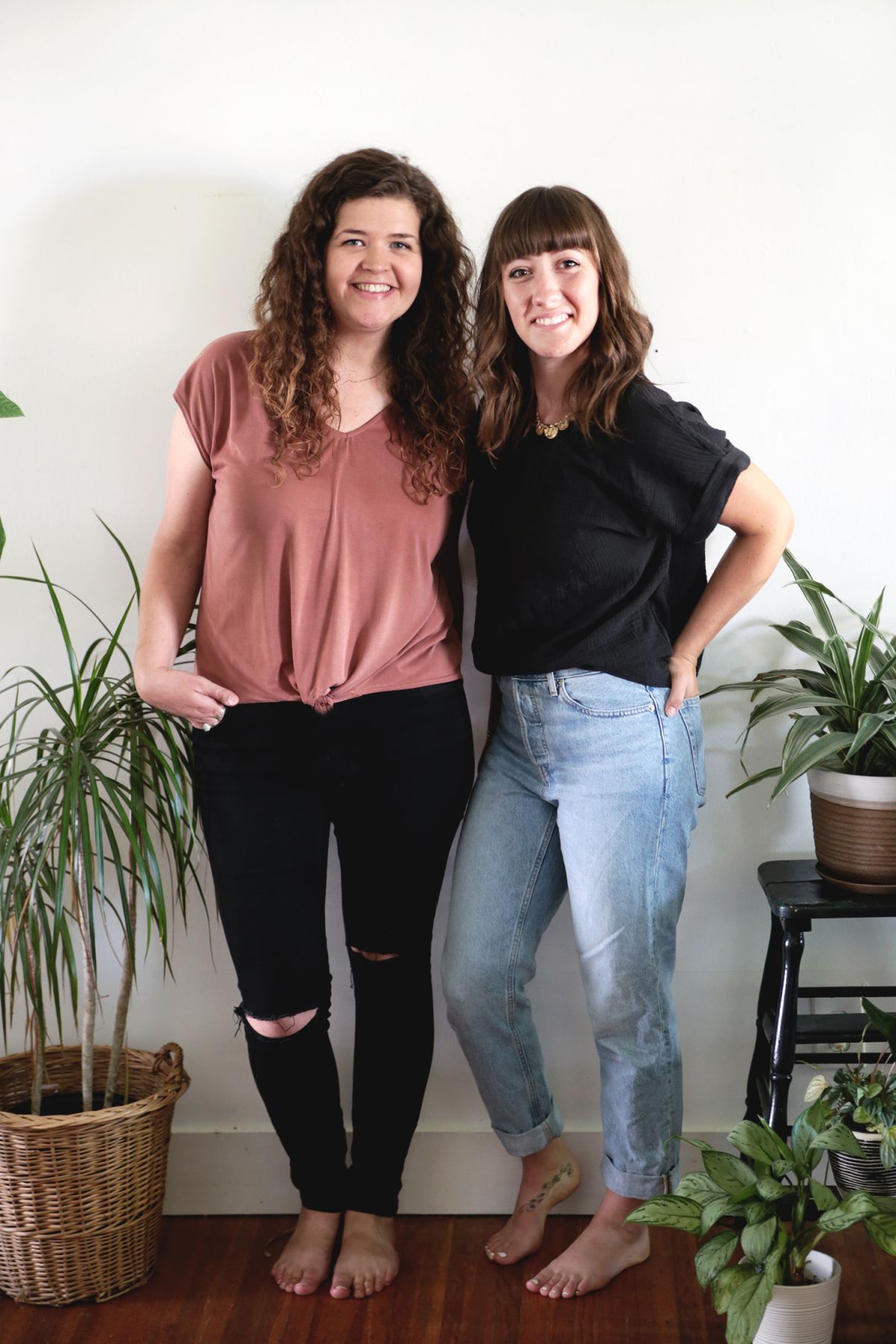Last week I shared our master bedroom makeover and now we’ll start getting into all the DIYs from the room. First up, this wood dowel headboard we made! A couple years ago, we moved our bedroom from downstairs to upstairs. We had every intention of building a new bed for our new room, so we got rid of our old bed frame, and only brought up the mattress. Fast forward a couple years and we were still sleeping on a mattress on the floor!! 😂🤦🏻♀️ First, I was having trouble deciding on a design for our bed. Then once I finally did come up with a design, other projects just kept taking priority over our bedroom. When we finally had a real bed and I was up off the floor, I was SOOO excited! I think being on the floor for so long made me appreciate having a bed all the more.
When coming up with a design for our bed, I knew I wanted something simple; and was a blend of modern and old styles. The dowels are modern but also give a similar look to old spindle beds. It was really inspired by this bed (that price tag and only being available in the UK were kind of a problem though – ha!). I loved the rounded look of that headboard. We wanted ours to be removable from the bed frame though, so we can change it up in the future. So we went this design, which just screws into an existing bed frame.
.jpg)
Originally, I wasn’t loving the idea of the angled end piece on the headboard, but Mike informed me this is what makes it supportive and sturdy so it doesn’t fall off when you lean against it…so I was good with it after I heard that! 😆 For those that would rather buy than DIY, we shared some similar spindle beds in this post.
This was also one of the first times we used a stain on wood instead of just a clear finish! It was a bit tricky trying to get the right color and actually almost made me want to give up and stick with clear finish, but I felt like the very light natural wood felt slightly too modern and the stain helped give it more of a classic look. (In an ideal world, I would be able to find the perfect tone of wood for every project without needing stain and without the wood being too light or too dark – haa! A girl can dream!). You can find the stain color combination we used below.
While we did make the entire bed, frame and headboard, this tutorial is just for the headboard. Our bed frame is a little bit more on the complicated part, and Mike didn’t want to try and get into explaining how to make that (ha!), so if you’re needing a bed frame too, you can use the tutorial we posted in the Live Edge Bed post, and adjust the measurements to fit your mattress size.
.jpg)
.jpg)
Supplies:
(This tutorial is for the headboard only. The bed frame we made is a little more complicated, but if you’re looking for a simple wood bed frame, you can use the tutorial from this post, adapting to the size you need for your mattress).
– wood board (at least 6 feet long if making queen size; we used maple wood)
– 3/4” dowels
– table saw
– mitre saw
– power planer
– square tool
– drill/drill press, drill bits
– screws
– hardwood plugs
– hammer
– clamps
– 2×4’s
– small ruler
.jpg)
.jpg)
.jpg)
Directions:
Using a table saw, cut two pieces of the board 1-1/4” wide by at least 72” long. (We cut our pieces 1/16” wider than we want to end up with so that when we power plane the edges, it ends up with the correct size.) Use a power planer to clean up the saw marks.
From these two pieces, cut two pieces 62” long (or the width of your bed).
Take one of the 62” pieces, and the two 10” pieces (which were left over), and using the table saw cut a half lap joint at each end of the long piece, and at one end of the short pieces. For a half lap joint, you remove half of the thickness of the wood, coming in from the end of the piece, 1-1/4”. Set up the saw with the blade 1-1/4” high and the fence 3/8 (if the wood is 3/4” thick) to the outside of the blade and cut the piece standing up with the 1-1/4” side against the fence. Then set the blade to 3/8” high and the fence to 1-1/4” to the outside of the blade, and cut with the 1-1/4” side down and and the side that is still 3/8” thick up.
From the remainder of your original board, cut a piece 7/8” wide by 72”. Turn the piece on edge and cut it to 5/8” thick. (Remember to add 1/16”). Use power planer to clean up the saw marks.
The notch is up on the ends of the long lower rail and down on the ends of the short side rails. Using the mitre saw, cut the short side rails with the notched side against the fence, cutting at a 17 degree angle, cut them 9” long to the tip of the angle.
For the angled end piece: Using the mitre saw, cut the 7/8” x 5/8” piece into two pieces 29-1/4” long; cutting at a 17 degree angle. With the 5/8” side against the fence, cut one end, measure from the tip of the angle and mark at 29-1/4” on the opposite side. Slide the piece down and cut. Repeat for the other piece.
Lay out the holes for the dowels. To figure out the spacing, take the measurement from notch to notch on the long lower rail and divide that number by the number of dowels, plus 1. We used 13 dowels, so we ended up with 4-1/4” between centers. Measure and mark for the13 dowels; mark in the center of the 62” piece and then mark every 4-1/4” in each direction, until there are 13 marks. Measure and mark to center the dowel hole, 5/8” from edge of board.
Lay the top rail beside the lower rail and using a square, transfer the marks onto the upper rail and then mark the centers. Using a drill or drill press and a 3/4” forstner bit, drill at each of the marks to a depth of just short of drilling through, using a stop will make this easier. Make sure to keep the drill bit perpendicular in each direction.
Measure the depth of the holes using a small ruler and subtract that number from the thickness of the rails; that will tell you how thick the remaining wood is. Double this number and subtract from the height you want the headboard to be. We wanted the total height of the headboard to be 28”. Using that number, cut your dowels to length using the mitre saw.
The easiest way to attach the angled end piece to the top rail and short side rail, is to use glue and screws. We went a little complicated and notched ours to attach it, to do that, follow these steps. Cut a 7/8” x 5/8” notch into the outside of the angled end of the short side rail pieces at the 17 degree angle of the end. Cut a 5/8” notch in each end of the upper rail at a 17 degree angle so that it is 7/8” back from the top front edge of the top rail. This was done on the table saw using the mitre gauge with a wood fence fastened to it.
Glue and clamp the short side rail pieces to the bottom rail. Allow to dry. Sand the upper rail and the bottom rail before installing the dowels. To make the installation of the dowels into the holes easier, sand the ends of the dowels so that the last 1/8” or so is at a slight angle instead of square.
Place the bottom rail unit on a flat firm surface. Place some glue into each of the holes, making sure to get a little glue all the way around the sides. Insert a dowel into each hole and tap into place lightly with a hammer. Place the top rail down on the flat surface and place glue in all the holes. Have a helper hold the bottom rail with the spindles pointing down, work your way down the length putting each dowel into a hole. Use a block of wood and tap on the bottom rail to help the dowels fit into the holes.
Use a couple of straight 2x4s and some clamps to clamp it together so that you are sure all the dowels are all the way in. Using a square, make sure that the dowels are perpendicular to the rails. Allow the glue to dry.
Set your angled end pieces in position and mark for holes to screw to the rails. Drill a 1/2” hole 5/16” deep at each location, and then drill a 3/16” hole in the center of these holes all the way through the piece. Glue and screw these to the headboard. Allow to dry. Put in hardwood plugs. Sand and apply finish (the stain combination we used is below).
Drill and counter sink holes in the bottom rail and short side rails so that you can screw the headboard to the frame of the bed. Attach headboard to bed frame using screws.
Stain Combination for Headboard and Bed frame:
We did a mixture of Minwax Natural (2 parts) with Minwax Early American (1 part). Then after that dried, we went over it with Minwax Dark Walnut. A little bit involved, but we couldn’t get the look we were going for with just one!
.jpg)
.jpg)
.jpg)
.jpg)
You can see more of the room in this post, and be sure to keep an eye out for more DIYs from this space coming soon! If you’re looking for more headboard ideas, check out our DIY Wood Slat Headboard, DIY Live Edge Wood Bed, DIY String Headboard, and DIY Plywood Print Headboard!
-Manda
Sources: Duvet Cover – c/o Magic Linen | Waffle Blanket – c/o Magic Linen | Lumbar Pillow Cover – c/o Magic Linen | Striped Sheet Set – c/o Magic Linen | White Pillows – Target | Nightstand – DIY | Wood Stool Nightstand – DIY | Brass Lamps – Lamps Plus | Minimal Planter – Convivial Production | Tall Ceramic Vase – no longer available, similar one (that I like better!) | Wood Essential Oil Tray – our Etsy Shop | Wood Clock – Amazon

.jpg)


